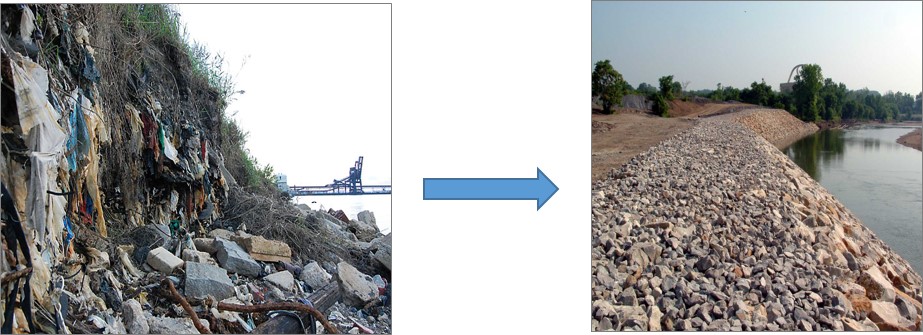Philadelphia Navy Yard Site Spotlight

The Navy Yard Gates
OVERVIEW -- The Philadelphia Navy Yard was, and continues to be a center of innovation and employment in the City of Philadelphia. After the closure of the shipyard and Naval base on September 27, 1996, the U.S. EPA and Navy partnered in a cleanup effort to revitalize the contaminated property. Today, after a tireless cleanup effort, the property is a modernized waterfront development with office complexes, industrial facilities, research laboratories, historic buildings, and a state-of-the-art 35-megawatt unregulated electric grid.
Photo courtesy of Philadelphia Industrial Development Corporation (PIDC).
(1 of 8)

SITE LOCATION - The Philadelphia Navy Yard is located 4 miles south of center city Philadelphia on 1,455 acres, with 348 acres comprising the former Philadelphia Naval Shipyard and the remainder the Philadelphia Naval Base. The facility is bounded by the Delaware and Schuylkill rivers and the City of Philadelphia. Visitors and employees can access the Navy Yard from South Philadelphia and Center City via free shuttle routes.
Photo Source: Google Maps
(2 of 8)

HISTORY - In 1801, the nation’s first government-owned shipyard, known as the Southwark Yard, was built in Philadelphia, where the U.S. Navy was born. During World War II’s peak production, the Navy Yard employed as many as 47,000 workers. After operating for 120 years, launching approximately 50 warships, and repairing over 1,200 ships, the site was designated for closure in 1990. The Defense Base Closure and Realignment Act (BRAC) II closed the Philadelphia Naval Base in 1991, and BRAC IV (1995) closed the shipyard, except for a few remaining support facilities.
Photos source: Official U.S. Navy Photograph, from the collections of the Naval Historical Center
(3 of 8)

THREATS AND CONTAMINANTS - The Navy constructed most of the buildings at the complex for industrial use, either for research and development or shipbuilding activities. Typical industrial activities at the shipyard included the power plant, the foundry, the paint shop and the electroplating plant. Various hazardous organic and inorganic chemicals were stored and used in these operations. To prepare the property for transfer, environmental assessment and cleanup began in 1991.
Pictured above are before and after scenes from the cleanup. The left depicts abandoned Navy Base buildings containing asbestos and lead, and the right depicts GlaxoSmithKline headquarters, now located at the Navy Yard.
(4 of 8)

Girard Point Landfill prior to and after remediation
CLEANUP - The Environmental Protection Agency (EPA), the Pennsylvania Department of Environmental Protection and the Navy worked closely with the Philadelphia Industrial Development Corporation, the company that would eventually manage the development of the property after transfer to the City of Philadelphia. These organizations coordinated efforts to ensure that the cleanup would be appropriate for the intended reuse of the property. The environmental cleanup work focused on asbestos abatement in buildings, polychlorinated biphenyl (PCB) transformer site remediation, removal of underground storage tanks and contaminated soil.
(5 of 8)

2013 Master Plan of the Navy Yard
LAND TRANSFER - Today, all Navy response actions required to support the transfer and reuse of the former Naval Complex have been implemented. This transfer and reuse has been the largest BRAC redevelopment project in EPA Region III, which included the $430 million Kvaerner (now Aker).
(6 of 8)

REDEVELOPMENT - Shipyard transfer in early 2000. Kvaerner, a European shipbuilding company, developed 100 acres of the former Naval shipyard as a modern shipbuilding facility. The company was bought by Aker and currently employs 1,200 workers.
Photo courtesy of Aker Philadelphia Shipyard
(7 of 8)

ECONOMIC BENEFITS - At full capacity, the Navy Yard complex will support more than 20,000 employees and reflect over $2 billion in private investment. There are currently 152 businesses in operation at the Navy Yard and over 12,000 people employed there. Major tenants include the corporate headquarters of Tastykake Baking Company, Urban Outfitters, and GlaxoSmithKline, as well as a surgical center and medical offices owned by Thomas Jefferson Hospital.
Recently, the Navy Yard also became home to Pennsylvania’s first community solar project. Watch video about the first community solar project, courtesy of PIDC.
Photo courtesy of PIDC
(8 of 8)
